|

AUSTRALIAN
HEMP HISTORY
From author John
Jiggen's book: "True
Hemp in Australia",
and other sources.
Before Federation:
1778: Sir Joseph
Banks, "the Father of Australia", the man who sent hemp
seeds on the First Fleet and devised the scheme for a convict
and hemp colony, must be claimed as hemp's Australian Godfather.
1800: As per Royal
instruction, the early Governors of New South Wales - Phillip,
Hunter and King - did their best to encourage the hemp industry.
By 1800, cloth manufacture had begun. In New Zealand a fibre plant,
used by the Maori population was noted, and named New Zealand
Flax (Phormium Tenax) and for the next sixty years, various
attempts were made to perfect an economic way to prepare it. The
Maori used to hand beat it. On Norfolk island, work continued
on phormium tenax, and an experimental planting of European
flax was begun. In Sydney, King (now Governor of New South Wales)
set dressers and weavers among the Irish convicts to cultivate
European flax and hemp, and "every woman that can spin"
to manufacture what these others grew. By the end of 1801, these
efforts had produced "279 yards of fine and 367 of coarse
linen" and he sent samples home. In 1801, King wrote about
European hemp which promised "a very abundant return on the
lowlands about the hawkesbury and Nepean rivers" and "might
also be manufactured and sent from hence in cordage". During
his period as Governor, King also had constructed a manufactory
for canvas, sacking, blanketing and rope.
1802 : NSW's governor
wrote Banks that he had sown 10 acres of "Indian hemp seeds" that
grew "with utmost luxuriance, generally from six to ten feet in
height." The governor and Banks did not seem to know that Cannabis
Indica was any different from European hemp.
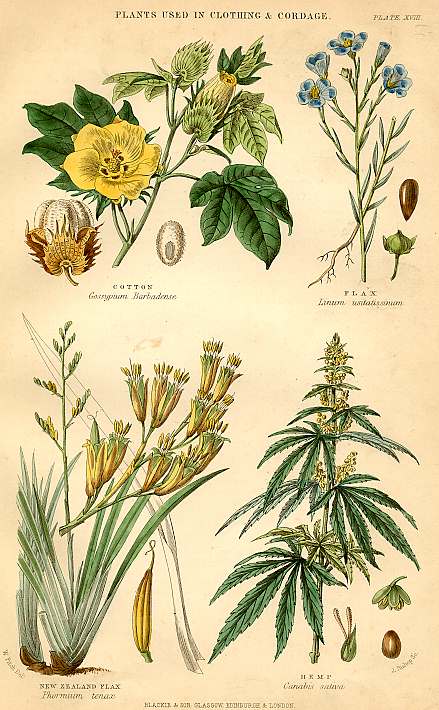 1808 - 1814: Shortage
of hemp in Britain due to Napoleon's blockade. Colonies encouraged
to produce hemp. 1808 - 1814: Shortage
of hemp in Britain due to Napoleon's blockade. Colonies encouraged
to produce hemp.
1813: An expedition
was mounted to New Zealand. Included in the crew was some of Samuel
Marsdens missionaries. (who had contact with the Maori cheif Ruatara)
and Robert Williams, the colonies first rope maker and flax dresser.
By 1814, Marsden had obtained 13,000 acres at Kerikeri and had
started a settlement there consisting of 22 settlers including
flax dresser, John King.
After his journey to New Zealand, Robert Williams made a long
submission to the British government about phormium tenax.
Reviewing the efforts by the British to work the New Zealand "hemp"
plant, Williams notes that: Phillip and King "were at much
labor and expense and made great efforts to bring it to perfection
at Norfolk Island...but the best mechanicks in Europe have failed
in their attempts to manufacture it."
Note: "Phormium Tenax", New Zealand Flax. The terms
seem interchangeable or collective in this era, as it changes
from one to the other in the text quoted. European Flax (Linum
usitatissimum) was different to New Zealand flax, and the New
Zealand flax did not easily respond to their efforts.
In his report, Williams claimed that he succeeded in solving the
mystery of dressing the New Zealand plant.
Very well aware that substantial encouragement is being offered
by the British government for processing hemp, Williams further
offered: "that the British market may be supplied with large
cargoes of hemp and in three years the principle part of the British
navy may be supplied from this territory and New Zealand at a
great saving from the average price of hemp from the north of
Europe."
This proposal by Williams for the cultivation of native "hemp"
in New Zealand and its manufacture into cordage was received with
interest in London and had the support of the commisioner of enquiry,
J. T. Bigge, who came to Australia to report on the colony's development
and agricultural choices as it moved on from being a penal colony.
Australia was now of little use as a penal colony, difficulties
having been overcome, and now people wanted to come. It was no
longer a forbidding destination.
1821: A rope made
by Williams from New Zealand "hemp" was tested in Chatham
rope yard and showed great strength. Mostly hand prepared (beaten)
flax is exported from now to 1860, when a mechanical method of
production is perfected.
1822: Williams
made plans to go to New Zealand but trouble with his debtor, Samuel
Levey, delayed him. (the debts were incurred when two boats were
burnt by the Maori's). To help Williams depart, the colonial government
made arrangements for Levey to be paid in cedar and land. 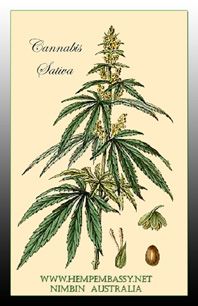
Archibald Bell's views on developing the colony: "The present
mode of farming here seems not to deserve the name of a system.
Wheat and maize are indeed almost the only crops raised, this
arises in the market for any other produce
...first, public encouragement should be given to the growth of
flax and hemp, the rich land on the banks of the Hawksebury and
Napean are capable of producing as we know by experience, the
most luxuriant crops, the manufacture of which would afford fit
employment for female convicts and lame men.
...the propriety of cultivating hemp and flax seems strongly pointed
out to notice, as in curing and preparing of so many hands would
be required, and would thus ensure for female convicts, (and also
lame and infirm old men now a burthen to the crown) a consideration
as it respects the female particular of no small importance to
the well being of morality."
Archibald Bell's views were echoed by Provost Marshall John Cambell
in a letter to the new Governor Sir Thomas Brisbane on February
12th 1822.
(Archibald Bell, who presented the argument for New South Wales
as a hemp colony to Bigge, was the chief police magistrate in
the Windsor area where he was the first paid magistrate and occupied
a government house valued at one thousand pounds. A member of
the New South Wales Corp, Bell had been in charge of the guard
at Government House in 1808 when Bligh was arrested. After Bligh's
arrest, he served as military commandant at the Hawkesbury, and
received a grant of a town allotment and 500 acres at Richmond,
and a larger grant of 1000 acres. He was one of those "with
the largest property and highest respectability" consulted
by Bigge, and he was appointed to the Legislative Council in 1832.)
Macarthur campaigned for a wool industry. We all know the outcome.
1846: Francis Campbell
publishes the first edition of the only Australian text on hemp.
"A Treatise on the Culture of Flax and Hemp". This collection
of essays was originally serialised in the Australasian. There
were two subsequent editions of this book in Campbells lifetime.
the third edition being published in 1864. The book was re-published
by Wild and Woolley in 1977, along with a marijuana growing guide.
Interestingly, the copy of the book in the Mitchell Library in
Sydney was donated by John Fairfax MLA, the founder of the Fairfax
dynasty.
1856: Victoria
imposes duty on opium: 21,890 kg imported in that year, earning
£56,979 in duty. The goldrushes and the opium smoking Chinese
population they attracted made imposts on opium a good source
of revenue.
1859: Demand for
hemp in Australia is high, but most seems to be imported. The
Sands Directory of New South Wales lists two rope manufacturers
in that year. After 1867 the industry grew and expanded. Between
1859 and 1890 about 39 rope businesses were listed. Only eight
were in existence by 1890 as business life expectancy was apparently
low.
1860:The production
of phormium tenax fibre on a large scale did not commence until
the late 1860s, when a machine was invented to beat the green
leaf between a revolving metal drum and a fixed metal bar. Metal
beaters on the surface of the drum struck the leaf at great speed,
stripping away the non-fibrous material and releasing the strands
of fibre. This machine (which became known as a �stripper�) produced
a much coarser fibre than the Maori hand-dressing process, but
one machine could produce about 250 kilograms (a quarter of a
tonne) of fibre per day, whereas one Maori worker (using a mussel
shell) could produce only one kilogram of fibre in the same time.
By 1910 the stripper had been improved to the point where it was
capable of producing 1.27 tonnes of fibre per day.
1868: Colonial
Monthly publishes the story "Cannabis Indica" written
by Marcus Clarke as an experiment while under the influence of
cannabis. He is out to thrill his readership rather than scientifically
record. "Cannabis Indica" is Australia's first recorded
drug writing.
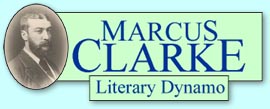 Ian
McLaren has described Marcus Clarke as "essentially the journalist.
He was able to sense a story; he was aggressive and combative,
ready to translate his thoughts into arresting words that caught
the imagination of the public, or aroused antagonism to his views
expressed so forthrightly" Ian
McLaren has described Marcus Clarke as "essentially the journalist.
He was able to sense a story; he was aggressive and combative,
ready to translate his thoughts into arresting words that caught
the imagination of the public, or aroused antagonism to his views
expressed so forthrightly"
. He was kept busy by the Argus and Australasian, writing leaders
and literary articles and reviewing books and theatre. A series
of articles, 'Lower Bohemia', about Melbourne low life appeared
in the Australasian and were particularly successful, being "strong
pieces of investigative journalism".
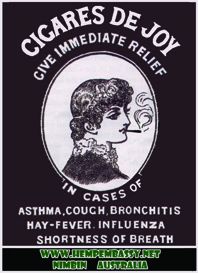 1880
- 1890: The use of now prohibited or restricted
drugs was widespread and tolerated to an extent that would cause
outcry today. For example laudanum, a household painkiller available
without a prescription, was a mixture of opium and alcohol and
was used for infants with teething problems. Cigares De Joy, marijuana
cigarettes were available in Australia and, to name just two of
the numerous drug-laced patent medicines available, Bonnington’s
Irish Moss contained opium alkaloids and Ayre’s Sarsaparilla
Mixtures contained opium. In the 1890s, morphine lozenges did
not come under the existing poisons legislation. Opium was seen
as a valuable commodity and was exported in vast quantities from
India into China to balance the British Empire’s tea trade.
The Opium Wars of 1839-42 and 1856-58 broke out as the Chinese
tried to resist the importation of the drug. 1880
- 1890: The use of now prohibited or restricted
drugs was widespread and tolerated to an extent that would cause
outcry today. For example laudanum, a household painkiller available
without a prescription, was a mixture of opium and alcohol and
was used for infants with teething problems. Cigares De Joy, marijuana
cigarettes were available in Australia and, to name just two of
the numerous drug-laced patent medicines available, Bonnington’s
Irish Moss contained opium alkaloids and Ayre’s Sarsaparilla
Mixtures contained opium. In the 1890s, morphine lozenges did
not come under the existing poisons legislation. Opium was seen
as a valuable commodity and was exported in vast quantities from
India into China to balance the British Empire’s tea trade.
The Opium Wars of 1839-42 and 1856-58 broke out as the Chinese
tried to resist the importation of the drug.
1891-1895: Some
early opium bills failed. For example, opium growing farmers of
Bacchus Marsh defeated the passage of a bill ‘to restrict
and regulate the sale and use of opium’. The Sale and Use
of Opium Act 1891 (Qld) controlled opium distribution, essentially
to protect Aborigines from being paid in opium. The growing awareness
of addiction meant growing opposition to free availability.
Opium Act 1895 was applied to South Australia and the Northern
Territory, making it an offence to sell or give to ‘any
Aboriginal native of Australia’.
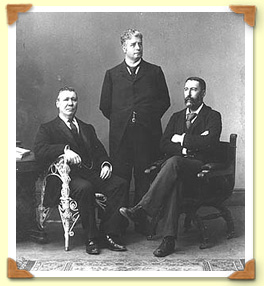 1897: At the Federal
Convention, Adelaide, March 1897, the drafting of the Australian
Constitution was entrusted to three lawyers shown here: Edmund
Barton (standing), John Downer (left) and Richard O’Connor.
Edmund Barton went on to become Australia’s first Prime
Minister. O’Connor and Barton were appointed to the High
Court in 1903.
1897: At the Federal
Convention, Adelaide, March 1897, the drafting of the Australian
Constitution was entrusted to three lawyers shown here: Edmund
Barton (standing), John Downer (left) and Richard O’Connor.
Edmund Barton went on to become Australia’s first Prime
Minister. O’Connor and Barton were appointed to the High
Court in 1903.
Act No 17 of 1897 (Qld) forbade sale of opium to Aborigines. Sale
of alcohol to Aborigines carried a £50 penalty, opium a
£100 penalty.
Post Federation
1900:Federation
of the Australian states into a new country. We are Australia.
1901: States give
up power to levy customs duties although they retained some Commonwealth
duties for some time.
Customs Act 1901 prohibits import of non medicinal opium to stop
recreational use spreading beyond Chinese community. Collector
of Customs grants licences to doctors and pharmacists.
1905: Commerce
(Trade Descriptions) Act 1905 (Cth) - controlled packaging, marking
and marketing of patent medicines (medicinal opium, morphine,
heroin, cannabis and others).
Premiers Conference – decision made to take action against
non-medicinal use of opium under pressure from feminist and church
groups, as more Europeans were believed to be smoking opium.
Opium Amendment Act 1905 (SA) – risk of fine and imprisonment
if non-medicinal opium sold, bartered or given to any race, ‘Asiatics’
risk deportation.
Opium Smoking Prohibition Act 1905 (Vic) - campaign supported
by Chinese merchants but focuses on Chinese opium smokers.
1907: Royal Commission
in Secret Drugs, Cures and Foods presented to Commonwealth gives
first warning of dangers of heroin, used as cough mixture. Commission
noted heroin in medicine not controlled.
1908: Police Offences
Act (NSW) – offence to sell, smoke or possess preparations
of opium for smoking. The Labor leader, W A Holman protested at
the use of opium being made an offence at law, when used ‘by
an adult man who knows what he is doing and is master of his own
actions’.
1910: Joint Commonwealth
State Conference - drugs for therapeutic purposes; dispensing
and labelling of medicines.
Customs Act s 233B(1) - non medicinal opium wide-ranging offences.
Shanghai International Opium Conference was held at the
insistence of USA, supported by European powers, China, Japan,
Siam and Persia.
1912: Hague International
Convention on Narcotics - control production and distribution
of raw and prepared opium (morphine and cocaine); required parties
to Convention to ‘examine possibility of making it a penal
offence to be in illegal possession of’ drugs covered by
the treaty.
1914: Dangerous
Drugs Act (UK) - adopts terms of Hague Convention re control of
drugs in treaty. Western powers more in touch with opium producing
countries.
1920: Australia
implements Hague Convention
1925: Geneva
Convention adds cannabis to Hague Convention narcotic list,
and sets up a permanent Central Opium Board to supervise international
trade in controlled drugs.
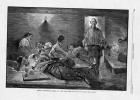 1926: Australian
Opium Proclamation prohibiting Coca leaves and Indian hemp. (This
is eleven years before America prohibits hemp.)
1926: Australian
Opium Proclamation prohibiting Coca leaves and Indian hemp. (This
is eleven years before America prohibits hemp.)
1931: Convention
on the Limitation Period in the International Sale of Goods (New
York) - signatories to give estimates of legitimate controlled
drug needs. Embargoes against signatories exceeding estimates.
1953: Ban on medicinal
use of heroin. Overprescription/unnecessary prescription by medical
profession prohibited.
1961: Single Convention
on Narcotic Drugs 1961 (New York) - schedules of drugs adopted
at conference of 71 nations:
Schedule I – opiate narcotics, cocaine and cannabis for
medical and scientific purposes.
Schedule IV – cannabis, cannabis resin and heroin ‘particularly
dangerous’, requiring more stringent controls. Signatories
to Convention to adopt whatever methods necessary. Article 36(1)
requires signatories to make production, possession, importation
and other activities serious offences to be punishable by imprisonment
(when committed intentionally).
1964:Cannabis found
growing wild in the Hunter Valley, survivors from early Australian
crops. Enormous newspaper publicity arouses public interest. Eradication
program begun.
1967: Appendix to
Narcotic Drugs Act 1967 adopted Single Convention. Domestic manufacturers
of narcotic drugs licenced.
1970: American
soldiers on R&R from Vietnam buy local pot and introduce more
potent strains. Kings Cross becomes a known centre for R&R
drug trade.
1971: Convention
on Psychotropic Substances extended beyond narcotic drugs to cover
drugs not listed in Single Convention Schedules. Dealings to be
controlled for medical purposes; more flexibility than Single
Convention.
1972: Protocol to
Single Convention - treatment or rehabilitation as alternative
to conviction or punishment.
 1973: Aquarius Festival
at Nimbin. Australian Union of Student's and Peter Stuyvesants
put on a festival that begat communes and cannabis and publicity. 1973: Aquarius Festival
at Nimbin. Australian Union of Student's and Peter Stuyvesants
put on a festival that begat communes and cannabis and publicity.
1976: Psychotropic
Substances Act 1976 incorporated 1971 Convention.
August 12th NSW
Police conduct a pre dawn raid on Tuntable Falls Co-operative,
rounding up 42 people at gunpoint, loading them into a mixture
of vehicles, including a cattle truck. There was a shortage of
pot at the time and only a pregnant mothers stash tin and a Sunshine
Milk tin containing twelve ounces was found on the entire property.
The Police said they would divide it among us to charge us all.
August
29th The Cedar Bay commune
is raided by Queensland Police. Using a helicopter, a naval patrol
boat and four wheel drives they rounded up the members of the
isolated community. Finding only a small quantity of marijuana,
the police discharged firearms into water tanks and burned down
the hippie's houses before they left. ZZZ radio
broke what would become an international story at the time.
All cannabis charges made in the course of the Tuntable Falls
raid were dismissed.
Queensland was the same, with compensation sought and gained
by some of the defendants.
1984: South Australia
decriminalised minor cannabis offences with a fine in expiation
of a charge for cannabis use, referral for assessment with option
of treatment and rehabilitation as alternative to prosecution.
1985: NSW comprehensive
schedule of drugs prohibited except on prescription.
1992: ACT - small
amounts cannabis police discretion re fine (NT follows in 1995).
First Nimbin MardiGrass Law Reform Rally
held after years of bi-annual helicopter raids that find little
to justify them, unless you believe the bizarrely optimistic $2000.00
a seedling formula the police employ?
1997: In September
Police use helicopters to raid the Wytaliba community, between
Grafton and Glen Innes in the Mann River valley. Despite being
videotaped they abused their powers by refusing to produce a search
warrant or identification, and using excessive force. Charges
were dismissed and the NSW police force sued.
1999-2000: NSW small
amounts of cannabis - police to direct offender’s attention
to harms and treatment - police cautioning system.
NSW trial of supervised heroin injecting rooms, modifying prohibition.
2000: The 100 or
so alternative lifestylers living at Wytaliba were in the mood
to celebrate hard. They'd just been awarded $1.3 million following
an unlawful search by police that happened to be captured on video
- including one policeman saying "we got no warrant".
2004: Medical Cannabis
flagged by Carr, but nothing happens. Howard can block it.
South Australian expiation notice scheme now only applies to
only a single outdoor plant.
In Western Australia from 22 March 2004 police have the discretion
to issue a Cannabis Infringement Notice to you if you are aged
18 years and over, and found to be:
- in possession of or using no more than 30 grams of cannabis;
- in possession of pipes or implements for use in smoking cannabis
on which there are detectable traces of cannabis;
- growing no more than two outdoor cannabis plants at your principal
place of residence, provided that no other person is growing other
cannabis plants on the same premises.
Federally the Conservatives consolidated at election time. The
size of the mortgage ruled the voters choice. Federally it is
still "zero tolerance".
Raids continue while the drugs of the twenty first century whistle
through our village, stimulants that provoke violence and vandalism
amongst some of the young. The cannabis smokers are still the
same peaceful lot they allways were, still protesting against
unfair laws, still putting on the MardiGrass every year, still
working to make the world a better place.
CREDIT:
Some of the information and points of view
in this Table are taken from John Lonie, A Social History of Drug
Control in Australia, Research Paper 8, Royal Commission into
the Non-Medical Use of Drugs South Australia, 1979 (The Sackville
Commission)
**********************************************
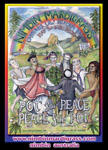 The Nimbin MardiGrass Law Reform
Rally will be held on the First
Sunday in May every year to encourage Australia
to change its laws, and for all to have a good time. The Nimbin MardiGrass Law Reform
Rally will be held on the First
Sunday in May every year to encourage Australia
to change its laws, and for all to have a good time.
Remenber, it is easier to argue with the wise, than it is to
argue with the ignorant. Stay cool.
http://www.hempembassy.net/
If you feel you have information that should be included in this
history, or that something is incorrect, feel free to send that
information and inclusion will be considered.......
Thank you for pot smoking and may the force be busy elsewhere
attending real crimes ......
Mail the
Hemp Embassy
Go to:
WORLD
HEMP HISTORY
ORIGINS
of NIMBIN MARDIGRASS
|